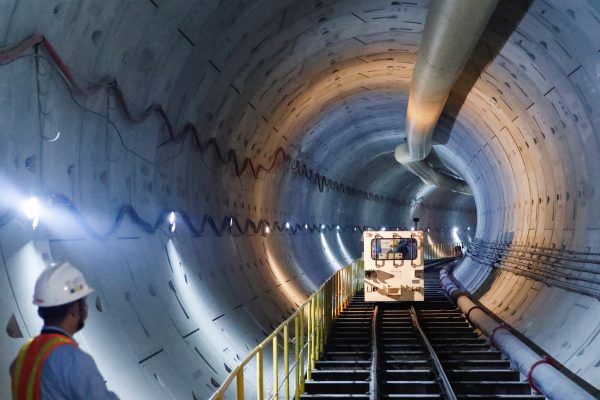Japan’s annual net ODA, most of which isdirected towards Asian countries, continues to grow despite some major setbacks. It grew from US$105 million in 1960 to US$14.5 billion in 1995, before declining when Japan’s asset bubble burst in 1992. Japan’s net ODA hit a low at US$7.7 billion in 2007, but rose to US$15.7 billion in 2021, with five ASEAN countries among the top 10 recipients. Much ODA went to the construction of roads, bridges, airports, powerplants and industrial estates, all essential to economic development.
Infrastructure aid was helpful to the original ASEAN members during their early independence. It benefited not only local people and firms but also attracted investment from Japan and other industrialised nations, which jump-started economic development. The same cycle repeated for the four new ASEAN members who joined in the 1990s. In mainland Southeast Asia, Japanese ODA enabled the construction of bridges and estates along Thailand’s Eastern Seaboard and the Mekong River, extending growth to the whole Mekong region.
But Japan’s contribution to infrastructure development among ASEAN states has also faced setbacks amid two long-term changes in Japan’s relative economic position. ASEAN’s infrastructure ambitions were easier to support when Japan’s economy was stronger and the cost of infrastructure investments in ASEAN countries fell below Japan’s aid allocation ceilings.
Over time, the gap between Japan’s and ASEAN’s infrastructure ambitions has shrunk. ASEAN countries want high-speed railways — Indonesia, Malaysia, Thailand and Vietnam have all expressed their intention to import Japanese bullet trains. Japan’s responses were positive but the costs exceeded ODA budgets.
Another change in Japan’s relative economic position has been the emergence of regional competitors with the technical capacity, financial resources and the political will to participate in infrastructure development in ASEAN. Depending on the type of infrastructure, China, South Korea and intra-ASEAN players such as Thailand have become active infrastructure providers in ASEAN. These new providers offer competitive pricing and are often more flexible in adjusting loan terms, cost provisions based on the constraints and accommodating the needs of recipient countries.
For example, Thailand has proposed reducing the speed and number of stops along the planned high-speed railway between Bangkok and Chiangmai as well as the overall contributions of the Japanese developer to reduce costs. Such requests do not appear to have been considered seriously. The new and more flexible regional providers have made it more difficult for Japan to settle deals while maintaining its high standards.
The ultimate goal is for ASEAN to become technically and financially capable enough to meet its own infrastructure aims. This is unlikely in the foreseeable future. Some ASEAN members are too small to foster local infrastructure industries. Local supply infrastructure scenarios are unrealistic even in the more economically advanced ASEAN member states, judging by the fact that catch-up by local firms is rarely seen even in less sophisticated industries. ASEAN’s infrastructure development will continue to rely on external assistance.
Despite difficulties in striking deals, Japan’s involvement may increase in importance given the complex and multifaced challenges that ASEAN nations are facing.
Ambition drives progress but overenthusiastic ambition may put ASEAN in difficult situations later. Japan is well-placed to help ASEAN nations evaluate their goals. It is usually the first partner that ASEAN countries turn to for feasibility studies of major infrastructure development projects. But Japan needs to be cautious about conforming to modern feasibility studies standards that overemphasise expensive ‘state-of-the-art’ criteria, which even developed countries struggle to afford. Focusing on realistic alternatives is more likely to lead to practical and appropriate outcomes.
Infrastructure development is difficult to execute because basic facilities have the character of both public and private goods. Public and private partnerships (PPP), where private companies fund government projects upfront and then earn revenue from their public use, may be the best way forward. This means larger contributions from public ODA and private players in the more developed ASEAN countries. The ‘build and leave’ alternative will not work in most ASEAN countries because of limited financial and technical capabilities. For PPP to work in modern infrastructure projects, such as high-speed railways, private partner commitments from developed countries are likely to be especially important.
Profitability and accountability to shareholders is the main reason that Japanese providers have been reluctant to proceed with bullet train projects in many ASEAN countries. But multinational manufacturing enterprises, including Japanese firms, have thrived in ASEAN for decades bearing the same accountability. The provision of infrastructure relies on higher-income consumers, while manufacturing companies benefit from lower wages. The shrinking income gap between Japan and ASEAN may make it easier for Japan to carry out FDI-oriented PPP for infrastructure development and expand Japanese infrastructure exports.
Japan’s FDI in some ASEAN countries has been overtaken by China or South Korea. But Japan is still number one when it comes to the network of aid and quasi-aid agencies across ASEAN. The Japan International Cooperation Agency and the Japan External Trade Organization still outperform similar organisations from China and South Korea in terms of the scale and range of operation and the impacts on local societies and economies.
Japanese manufacturing companies have shown how cross-border cooperation is an effective way to achieve overall efficiency in ASEAN. An infrastructure project that is not feasible in one ASEAN country may become viable when connected with infrastructure in other ASEAN countries. With its aid and quasi-aid networks, Japan is well-placed to coordinate intra- and extra-regional assistance with Europe, the United States, China and other countries to promote ASEAN’s continued infrastructure development.
Souknilanh Keola is Deputy Director of the Economic Geography Studies Group at the Institute for Developing Economies, Japan.

